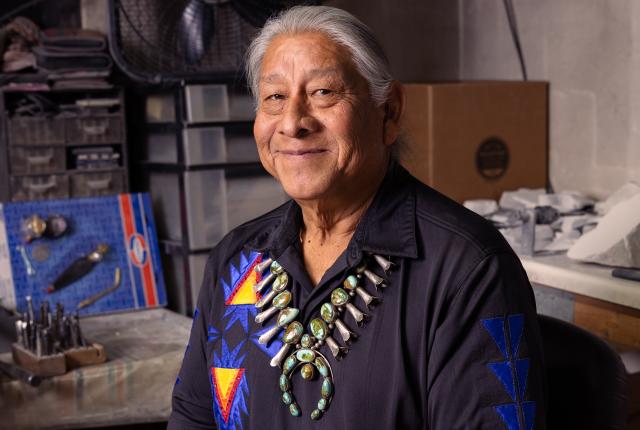JEWELER ANTHONY LOVATO DRAWS CREATIVE INSPIRATION from his rich family history of potters, basket weavers, and silversmiths. The fifth-generation Santo Domingo (Kewa) artist specializes in tufa casting, in which molten precious metal is poured into meticulously carved sandstone molds. The delicate practice not only imparts a striking, sandpaper-like texture; it also yields an intricate pattern that covers the inside and outside surfaces. A graduate of Santa Fe’s Institute of American Indian Arts, Lovato worked at Flagstaff’s Museum of Northern Arizona before returning to New Mexico in 1984. He has lived and worked on Santo Domingo Pueblo ever since. “I am constantly inspired by ancient petroglyphs,” says Lovato. “I’m always visiting ruins to study them and to try to recreate their beauty.” As part of this month’s Native Treasures Art Market, Lovato is being honored as the Museum of Indian Arts and Culture’s Living Treasure, which recognizes Native Americans who have made a significant impact on Indigenous arts and culture.
FAMILY IS EVERYTHING, from the lineage of artists in my family who came before me, down to my four sons, all of whom are following in my footsteps as artists.
ONE OF MY PROUDEST MOMENTS as an artist was on a flight heading home from Phoenix. I was wearing one of my bracelets, and the person sitting next to me said, “That looks like an Anthony Lovato design.” It was surreal.
EVERYTHING ABOUT NEW MEXICO inspires me—the sun, the rivers, the trees, the mountains. It all mixes together and makes me feel so lucky our ancestors put us here.
I NEVER CONSIDER MYSELF A MASTER because I learn every day. As artists, I believe we never really finish what we want to do creatively, because there are too many ideas and life is too short.
IN MY FAMILY, CORN IMAGERY dates back for many generations. Southwestern pueblo family groups consist of individual clans, passed down matrilineally, and my mom was born into the Corn clan.
IT’S EASY TO BE INSPIRED BY CORN: It’s nourishing, sustainable, and it gave my ancestors life.
IF I WASN’T A JEWELER, I might have picked up pottery, which Santo Domingo has been known for.
I WORKED at the Museum of Northern Arizona in Flagstaff, and I loved learning about Arizona and its people. I might as well be a Native American art historian, because over the years I’ve continued learning about all kinds of our peoples’ art—from paintings to baskets.
THERE IS ALWAYS A SHOW around the corner I need to prepare for. More intricate pieces can easily take me a week to make, so I’m always working on something.
ONE THING ABOUT SANTO DOMINGO is how isolated it is. We’re between Santa Fe and Albuquerque, and it’s easy to drive right past us.
WHEN I’M AWAY FROM HOME, I miss normal life, which includes taking care of horses, cutting wood, hunting elk and mule deer, and being with family.
THE MOST CHALLENGING ASPECT OF TUFA CASTING is also the most rewarding. Working with sandstone and liquid metals is unpredictable. You’re working in reverse, and you never know exactly how a piece will turn out, but that’s what makes it so exciting.
MY GOAL AS AN ARTIST is to get the designs from my creative spirit to translate into a piece. When I can successfully actualize that vision, it’s pretty exciting.
THE JEWELRY I MAKE IS AN INVESTMENT, and my advice to collectors is to do your research and discover why it’s worth it.
SEE FOR YOURSELF
Celebrate Anthony Lovato and purchase his work at the Native Treasures Night Market on Friday, May 26, and all weekend at the Santa Fe Community Convention Center. miac.eventbrite.com


